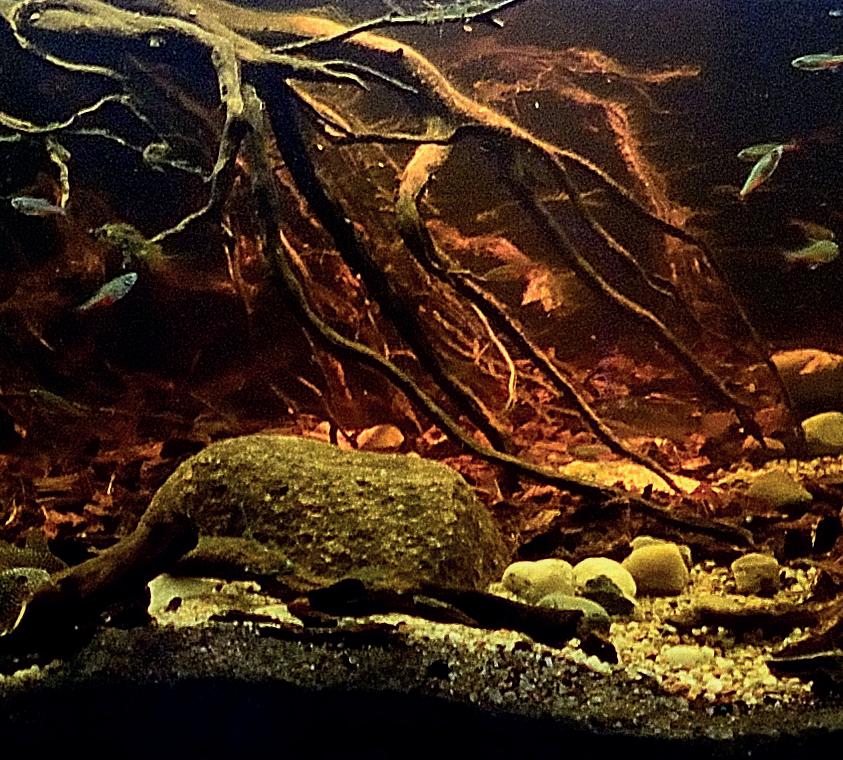
15 minute read
Rules of proper supplementation in reptile nutrition – Dawid Krótki
RULES OF PROPER
Advertisement
Dawid KRÓTKI
A graduate of the Faculty of Animal Breeding and Biology at the University of Agriculture in Krakow. Breeder of African and South American cichlids. An expert in the feeding and breeding of reptiles, amphibians and all kinds of invertebrates. Author of many aquarium and terrarium articles.

The subject of this article is one of the most widely discussed issues at trade fairs, expert meetings, and online. It does not surprise me at all, because – apart from proper terrarium equipment and diet – mineral and vitamin supplementation is one of the key factors that determine good condition of the animals and our breeding success.
WHY IS SUPPLEMENTATION SO IMPORTANT? Despite their caretakers’ efforts, reptiles living in terraria do not receive food as rich in minerals and vitamins as they would in their natural environment. Farmed insects, while rich in protein and fat, are poor in calcium. They also have an abnormal calcium to phosphorus ratio. Hence this food is not as varied as in nature. Typically, the reptile menu in terraria is limited to 4-5 types of insects (crickets, cockroaches, locusts, mealworms, super worms), which is only a small fraction of what is available for animals to eat in the wild. In addition to insects, reptiles often eat snails, centipedes, spiders, and crustaceans. There is a reason why ”meadow plankton” was once considered the best food source for insectivorous reptiles. Today, due to the widespread use of pesticides, it is unfortunately too risky to feed reptiles with. Furthermore, the soils and rocks in the natural habitats of our reptiles are very often much richer in essential minerals and the animals can lick them off. Many reptiles also tend to instinctively swallow bits of substrate. Hobbyists generally do not have access to plants and animals typical of the area in which their reptiles originate, so they have to use substitutes
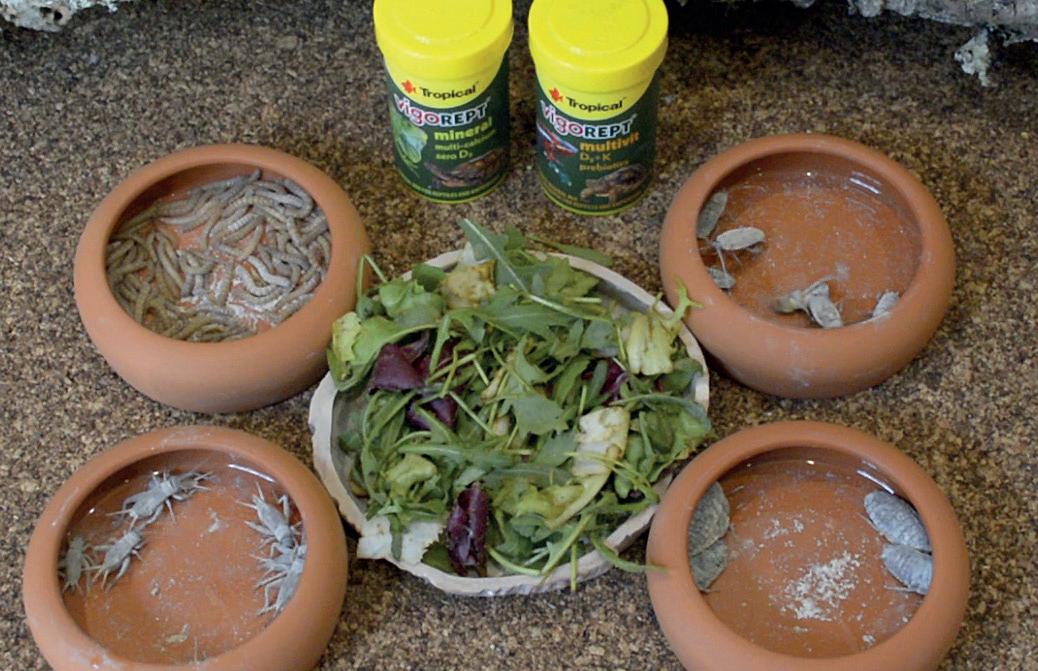
that do not always cover the reptiles’ nutrient, vitamin, and macro- and micronutrient needs. Plants from arid and semi-arid areas often have much higher tissue calcium levels than green plants we provide in terrariums. Access of reptiles to sunlight is also of great importance. It not only provides life-giving warmth needed to maintain metabolism at an appropriate level, but also enables the production of vitamin D3, which is synthesized in the skin under the influence of UV-B radiation. Under terrarium conditions, the quality and timing of illumination are not always sufficient to ensure adequate vitamin D3 production. This is why supplements, which ensure essential vitamins and minerals, are so important in reptile diet. However, application is not as simple and obvious as it might first appear. Developing the right dietary supplementation system for your reptile requires a great deal of knowledge on the biology of the species, its environmental and nutritional requirements, and an understanding of the mechanisms regulating calcium-phosphorus balance in the body. The effects of an overdose are just as dangerous as a deficiency. Why is it that there is no strict guidelines on the nutritional requirements for specific nutrients, vitamins and minerals in specific reptile species? I will try to answer this question and others in the following text. Proper mineral-vitamin balance is very important as it improves appetite, vitality, condition and ability to fight infections. We have little research on the nutritional requirements of specific reptile species, and this issue has never been studied on a large scale. (Definitely the situation looks better in the case of dogs and cats – after all, these animals have been accompanying humans for centuries – but even here it should be noted that while the veterinary dietetics of dogs is already relatively well known, with cats scientists are still at the beginning of the road and we are only just learning about the exact cats de-

mands for nutrients, minerals and vitamins). Previous studies in reptiles have shown interspecies and geographic variation in the requirement for these components. Although there are references to the first terrariums dating back to the 19th century (some were heated with glowing coal), the trend of keeping exotic reptiles in home terrariums emerged in the last century and only became popular after 2000. However, various studies have been conducted on reptile metabolism and mechanisms of mineral and vitamin regulation. Based on their results, knowledge of the biology of the species and experience in working with ectothermic animals such as reptiles, the breeders must work out their own system of calcium and vitamin supplementation. The basis will always be an adequate diet, as varied as possible.
WHAT IS THE PROBLEM AND WHAT NEEDS SPECIAL ATTENTION?
There are usually three undesirable situations: 1. Too little calcium in the diet and too little calcium relative to phosphorus Calcium has an important function in many metabolic processes. Among other things, it is responsible for muscle contractility, nerve conduction, blood clotting, cell membrane permeability, enzyme activity, and bone metabolism. In the life of every reptile there are several stages during which it is very important to provide the right amount of calcium in the diet. The first is the process of growth, when a large amount of calcium is required to support the building of the skeleton as other tissues grow. As the animal reaches maturity, the demand for calcium drops because the growth is stunted. Reptiles grow throughout their lives, but this growth


Before feeding the reptiles with insects, place them in a container with an appropriate amount of the product and shake gently
is slower as they reach maturity and tends to decrease with age ever after. Females, on the other hand, need extra calcium when they go into reproduction. The formation of eggshells calls for huge amounts of calcium. If you don’t provide enough in the diet, the body will “steal” calcium from the bones to make an eggshell. According to many authors, the optimal dietary calcium content is 1-2%. All reputable reptile food companies declare this value in their products. These data are based primarily on studies of the nutritional requirements of chicks and other poultry and on many years of observation. The calcium to phosphorus ratio is also important. Optimally, it should be 2:1 (calcium:phosphorus). This is the ratio obtained in blood serum analysis of most vertebrates. When the ratio in serum is reversed in favor of phosphorus (due to a decrease in calcium), the body seeks to achieve adequate levels by recovering calcium from blood plasma from calcium-containing tissues, especially bone and calcium itself is lost with urine. If we then fail to supply the body with adequate amounts of calcium, this condition will lead to metabolic bone disease (MBD). The most common dietary source of calcium is a common calcium carbonate. It is characterized by relatively high calcium content (about 40% Ca), but its absorption in the intestines is poor. Compounds such as calcium lactate (17.5% Ca), calcium gluconate (9% Ca) or calcium citrate (24% Ca) contain a lower percentage of calcium than carbonate, but the possibility of absorption, or its availability to the body, is much greater than of calcium from carbonate. The best option is to use products that contain diverse sources of calcium and at the same time do not contain vitamin D3. They can be administered with each meal without the risk of overdosing vitamin D3. It’s important to know the exact calcium percentage in the formula so you can calculate the right
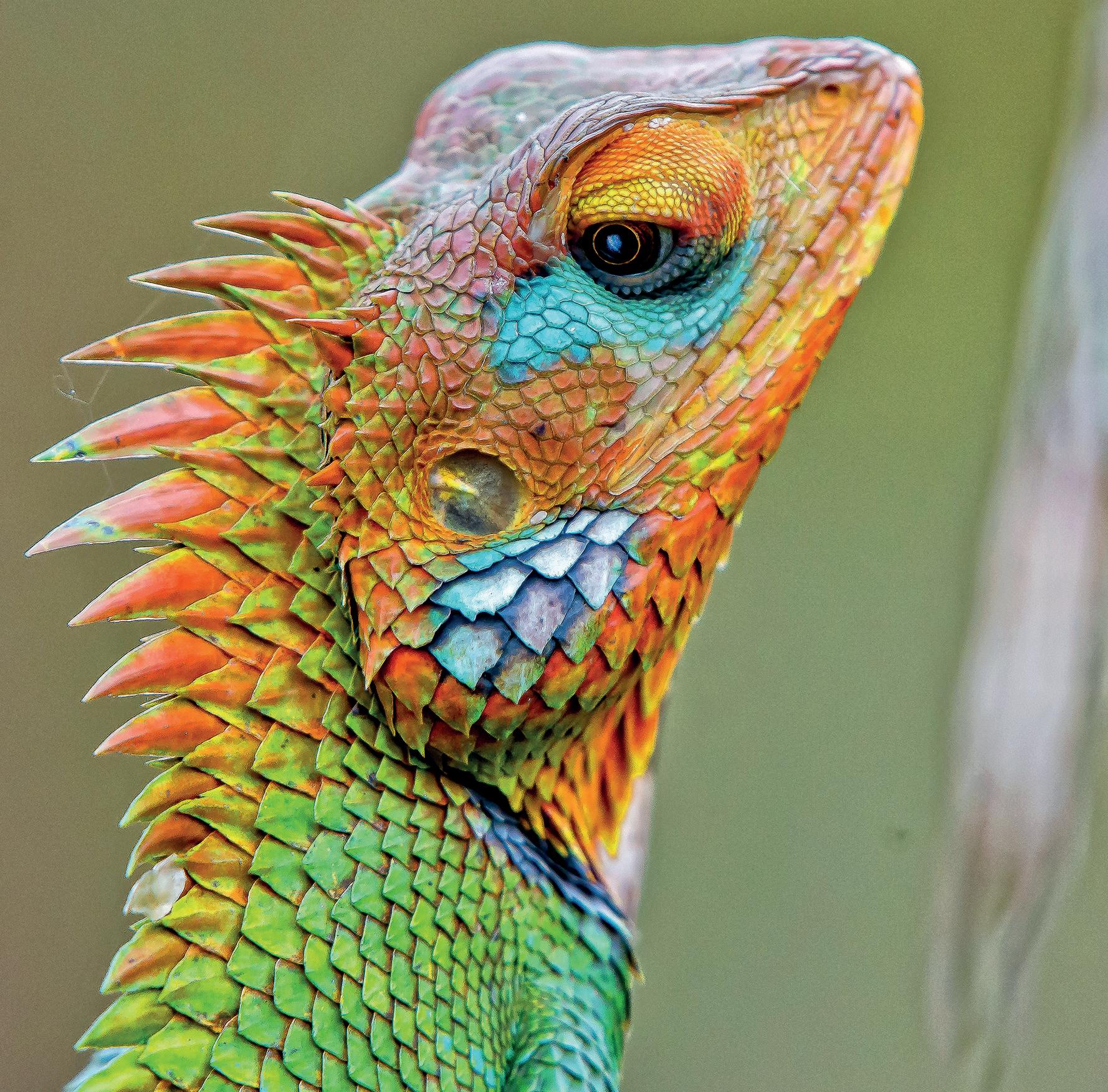
dose for your reptile. With a 29% calcium formulation, 6 g of the formulation would need to be fed per 100 g of food to achieve the desired calcium content in the diet (1-2% Ca). Plant foods should be sprinkled with the product and stirred thoroughly. Insects for insectivorous animals should be put into a small box or bag, then sprinkled with the preparation and shaken gently several times so that the powder covers the insect bodies. When you give the preparation to your pet the first time it’s a good idea to weigh the standard portion you give your pet, to calculate from the proportions how many grams of the product should be given. Special attention should be paid to preventing calcium deficiencies in the diet in times of increased demand (growth, reproduction) and during convalescence.
2. Vitamin D3 deficiency Vitamin D3 is the most important vitamin in reptile nutrition. Its deficiency causes inhibition of calcium absorption from the gastrointestinal tract into the blood and results in the disruption of the correct calcium-phosphorus ratio.
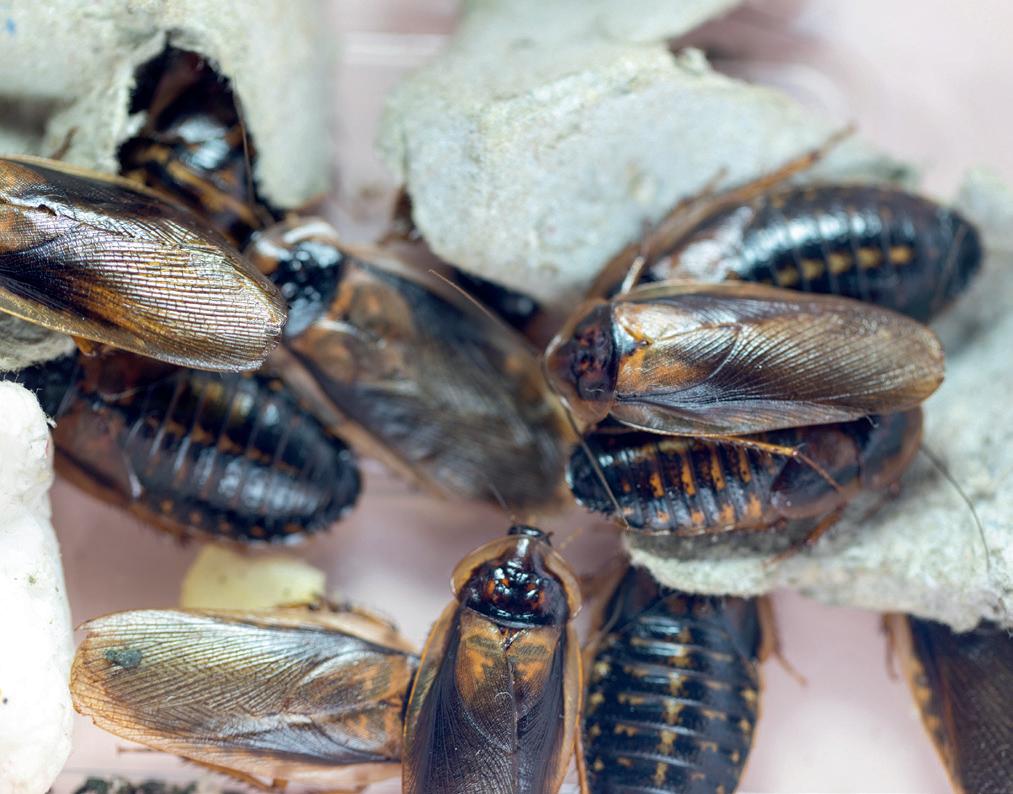
The Dubia Roach (Blaptica dubia) Jamaican Field Cricket (Gryllus assimilis)

In such a situation, as in the case of dietary calcium deficiency, the body seeks to balance this ratio by recovering the calcium stored primarily in the bones. The accompanying disease, called secondary hyperparathyroidism, leads to MBD. As a result, the parathyroid glands release parathormone, under whose influence calcium is released from the bones, which directly contributes to rickets. Advanced symptoms of the disease include a limp jaw (as if made of rubber), broken or deformed limbs, ribs and spine. Under natural conditions, vitamin D3 is synthesized by the action of ultraviolet radiation from the sun. In the skin of reptiles, previtamin D3 is formed from 7-dehydrocholesterol, which undergoes photoisomerization under the influence of UV-B radiation of 290-315 nm wavelength. This then converts to the inactive form of vitamin D3 – cholecalciferol – under the influence of heat. Cholecalciferol binds to plasma proteins, which are transported to the liver and converted to calcifediol. Calcifediol is then transported to the kidneys and converted to calcitriol, the active form of vitamin D3. It is calcitriol that facilitates the absorption of calcium from food in the digestive tract. Therefore, providing calcium in the diet alone is not enough. In case of vitamin D3 deficiency, calcium from food will not be absorbed into the blood. This vitamin is also found in the liver and kidneys of vertebrates. Therefore,
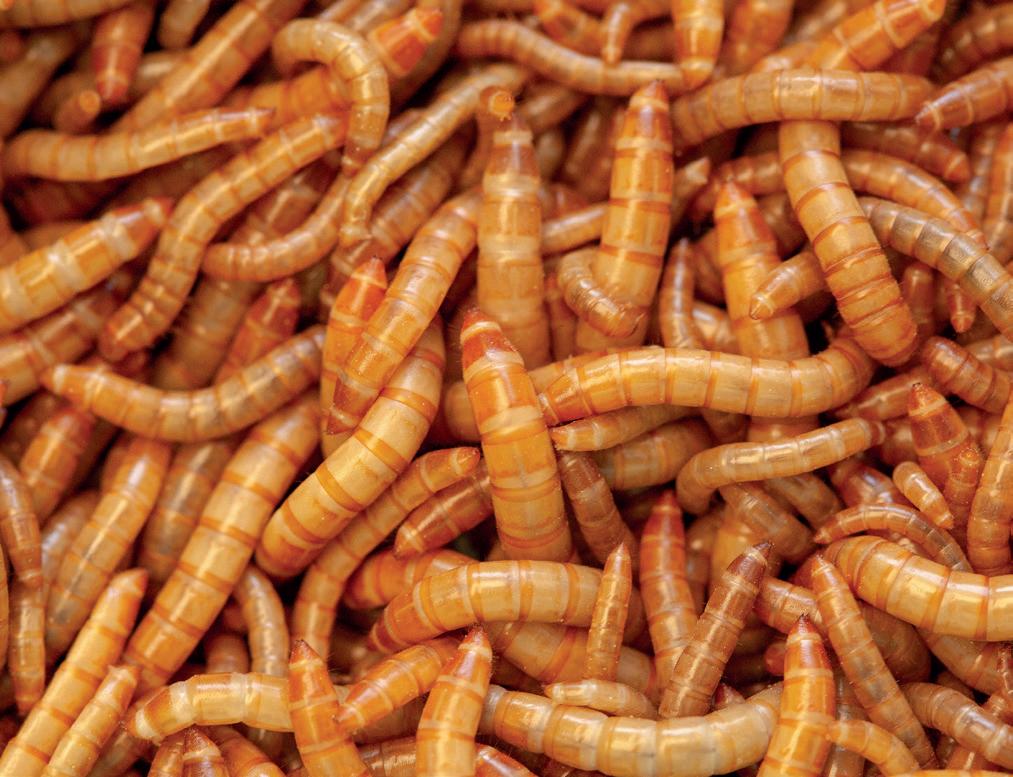


Young reptiles have an increased demand for calcium due to the growth and development of their bony skeleton; photo by Dawid Krótki
animals that eat whole vertebrates – for example, snakes, monitors or crocodiles – rarely suffer from deficiencies of this vitamin and the supplementation is not needed. Most captive-bred reptiles are kept indoors, without access to natural sunlight. In such conditions, if the terrarium is not equipped with specialized lamps that provide UV-B radiation for the production of vitamin D3 in the skin, there is a high risk of deficiency of this vitamin. This deficiency – due to impaired calcium absorption from food – lead in a straight line to weakened bones, rickets, convulsions and neurological disorders. Therefore, reptiles should be given free access to UV-B radiation, as this is the safest way to ensure adequate production of vitamin D3. However, note that the UV-B emission efficiency of specialist terrarium lamps decreases with time. In the case of tubular and compact fluorescent lamps, their efficiency drops noticeably after just a few months of use, so they should be replaced regularly with new ones. Metal halide lamps are much more durable and effective in UV-B emissions, but their spectrum is also depleted over time. It is worth to regularly check the efficiency of the lamps with a suitable meter. We treat supplementation only as a way of covering up for any deficiencies that we should not allow. It is difficult to determine the exact dose without knowing the needs of the animal – so be careful not to overdose on vitamins. Optimal solution is using products containing 20 000-60 000 IU/kg of D3, which are generally considered safe for reptiles. For reptiles that are active during the day, and are within range of good quality UV-B radiation, it is sufficient to add a vitamin supplement with D3 to the food 3-4 times a month. Satisfying the needs of nocturnal spe-
cies may prove more difficult, as these reptiles are active from dusk to dawn and will avoid light and thus will not benefit from the presence of UV-B in the terrarium. So in their case we should use vitamin D3 supplementation more often, even every second or third feeding. Herbivorous reptiles, such as tortoises and green iguanas, need the most attention in vitamin D3 supplementation, as it is assumed that these animals have limited capacity to absorb this vitamin through the oral route.
3. Too much calcium and vitamin D3 in the diet In general, there is little risk of calcium overdose without excessive amounts of vitamin D3. However, too much calcium given at once can affect the efficiency of digestion by neutralizing stomach acids and raising the pH in the stomach, which is not desirable. That’s why we don’t give reptiles calcium in the form of mineral preparations for the future, nor do we try to quickly make up for previous negligence and deficiencies in supplementation. Large doses of calcium will not produce the same results as smaller amounts given at each feeding. If extremely large amounts of calcium are served at one time, there may be a risk of ”concreting” the lumen of the digestive tract, especially in small and delicate species. Insects should be lightly sprinkled with mineral preparation, not coated with it. If we provide too much vitamin D3 in the diet, there is a risk of excess calcium being deposited in the tissues, which is also not good.
OTHER VITAMINS The next vitamins – the most important from the reptile keeper’s point of view – are vitamin A and K2. Vitamin A is a group of organic compounds called retinoids, the most important of which is retinol. Retinol is responsible for eyesight. It also affects bone growth and development. In the body, it is responsible for the proper function-
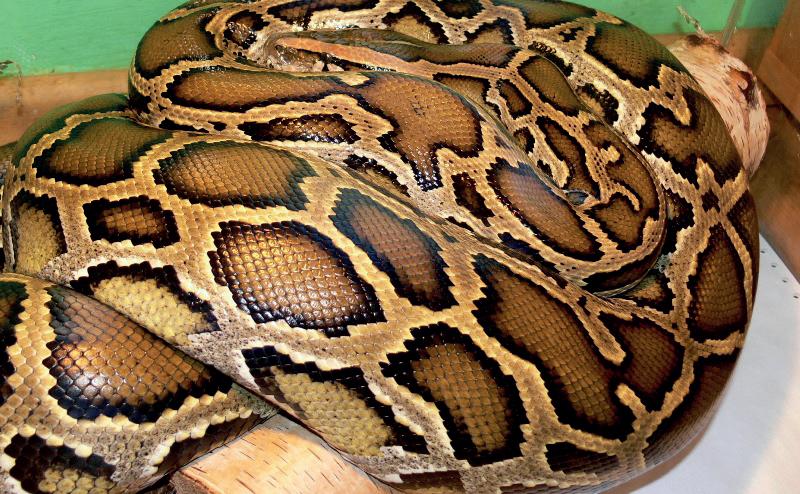

ing of epithelial tissue: skin, cornea, gastrointestinal tract and respiratory system. It is mainly contained in the liver of vertebrates and fish oil. However, its precursors, or previtamins, are carotenoids derived from plant matter, of which beta-carotene is the most significant. Omnivores and herbivores have the ability to convert carotenoids into retinol. Besides, carotenoids are great antioxidants and they enhance coloration, especially orange and red colors. They are an important element of a balanced diet. It is questionable whether carnivorous reptiles such as snakes and monitors can convert carotenoids into vitamin A and more research is needed to be sure they do not have this ability. Vitamin K plays an important role in bone and blood vessel metabolism, cell growth and apoptosis as well as prevention of vessel and soft tissue calcification. In bone metabolism, it is responsible for capturing calcium from the blood and building it into bone tissue. Vitamin K deficiency is relatively rare and has been observed mainly in crocodiles. Vitamin K is a collective name that includes a group of derivative compounds found in the form of vitamin K1 (phylloquinone), synthesized by plants, and vitamin K2 (menaquinone), synthesized by bacteria. Vitamin K2 is mainly found in animal products and soy fermentation products. The third form is vitamin K3, or menadione, a synthetic analogue of vitamin K that may be a precursor to vitamin K2 in vertebrate organisms. Vitamin K2 is normally produced by bacteria in the digestive tract. However, long-term administration of antibiotics can significantly reduce the number of probiotic bacteria, causing insufficient production of vitamin K2. Its deficiency is usually manifested by spontaneous hemorrhages, similar to bleeding gums.
SUMMARY As you can see, the problem of mineral and vitamin supplementation is an extremely complex one, and it depends on many factors. There are no sufficient data to determine specific mineral and vitamin requirements for specific species. However, with appropriate knowledge and experience, we can successfully reduce the risk of both deficiencies and overdoses of these substances in terrarium animals. I would like to stress again that the most important in prevention of metabolic bone diseases in reptiles is to provide appropriate environmental conditions in the terrarium, the most varied and high quality diet possible and a sensible supplementation with mineral and mineral-vitamin products.
LITERATURE Frye F.F., Stosunek wapnia do fosforu w diecie legwana zielonego, Biuletyn SOZ PTZool, nr 10, 2003. Kolb S., Nutritional Secondary Hyperparathyroidism in reptiles, Veterinary Nursing in Action (Oct/Nov), 2017. Konkol D., Cholewińska P., Błędy żywieniowe i wynikające z nich choroby metaboliczne gadów, Życie Weterynaryjne 93(8), 2018. Laing C.J., Fraser D.R., The vitamin D system in iguanian lizards, Comparative Biochemistry and Physiology, Part B 00 373–379, 1999. Mancinelli E., Overview of common nutritional disorders of captive reptiles, Vet Times – The website for the veterinary profession, September 21, 2015, https://www.vettimes.co.uk. McWilliams D.A., Nutrition research on calcium homeostasis. I. Lizards (with recommendations), Int. Zoo Yb. 39, p. 69–77, 2005. Pough F.H., Recommendations for the Care of Amphibians and Reptiles in Academic Institutions, National Academy Press, 33(4), Washington 1991. Stahl Scott J., Feeding carnivorous and omnivorous reptiles, DVM, DABVP (Avian) Proceedings, Association of Reptilian and Amphibian Veterinarians, 2000. Xie S., Low Ji Z., Vitamin A Balance in Reptiles, Conference: Singapore Veterinary Association/Asian Society of Zoo and Wildlife Medicine/Unusual and Exotic Pet Veterinarians/Association of Avian Veterinarians – Australasian Committee Joint Conference, 2013.




